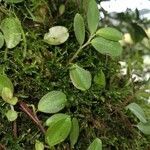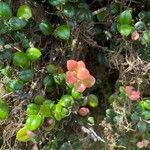A small, repent herb; stem filiform, scarcely 1 mm. thick, fruiting branches short, erect, moderately crisp-puberulent or somewhat villous glabrescent; leaves alternate, round, about 5 mm. in diameter, or round-elliptic or subobovate and up to 10 mm. wide X 12 mm. long, apex obtuse, base rounded-subpeltate with the lower margin scarcely continuous over the petiole, or sub-acute, moderately crisp-puberulent, loosely villous, or commonly glabrescent, more or less ciliate, obscurely palmately 3-nerved, often glandular-dotted, drying membranous; petiole commonly 1-5 mm. long, or occasionally up to 10 mm.; spikes solitary, scarcely 1 mm. thick X 2 cm. long, or occasionally somewhat longer, terminating short branches which commonly bear 1-3 or 4 leaves reduced in size upward; peduncle 3-5 mm. or rarely up to 10 mm. long, crisp-puberulent or glabrate; bracts round-peltate; fruit about 0.8 mm. long, globose-ovoid, apex oblique, stigma subapical.
Epiphytic or epilithic herb, prostrate with ascending stem tips rooting at nodes. Stem crisp-pubescent when young, internodes 0.3-2 cm long, green often with red spots. Leaves alternate, basely attached, sometimes subpeltate, fertile branches often with distally progressively smaller leaves; petiole up to 1 cm long, pubescent to glabrous; blades fleshy or fleshy coriaceous, broadly elliptic to elliptic or almost orbicular, (0.5-)1-1.2 x (0.5-)1-1.2 cm, margin ciliate, apex rounded, base rounded, glabrous to puberulent; obsolete palmately 3-veined. Inflorescence terminal, solitary; peduncle not nodose, without bract, up to 1 cm long, pubescent or glabrous; spike 2-6 cm long, yellow to red, moderately to densely flowered; floral bracts rounded, glabrous, glandular. Fruits (sub)basely attached, globose to ovoid, brown, reticulately verruculose, apex oblique with subapical stigma.
Epiphytic or epilithic herb, prostrate with ascending stem tips rooting at nodes. Stem crisp-pubescent when young, internodes 0.3-2 cm long, green often with red spots. Leaves alternate, basely attached, sometimes subpeltate, fertile branches often with distally progressively smaller leaves; petiole up to 1 cm long, pubescent to glabrous; blades fleshy or fleshy coriaceous, broadly elliptic to elliptic or almost orbicular, (0.5-)1-1.2 x (0.5-)1-1.2 cm, margin ciliate, apex rounded, base rounded, glabrous to puberulent; obsolete palmately 3-veined. Inflorescence terminal, solitary; peduncle not nodose, without bract, up to 1 cm long, pubescent or glabrous; spike 2-6 cm long, yellow to red, moderately to densely flowered; floral bracts rounded, glabrous, glandular. Fruits (sub)basely attached, globose to ovoid, brown, reticulately verruculose, apex oblique with subapical stigma.
Leaves alternate; petiole 1–5 mm long, very slender; lamina 2–9(12) mm long, circular to elliptic, rounded and sometimes emarginate at the apex, cuneate at the base, rather thickly fleshy and rigid, ± sparsely puberulous on both surfaces, ciliate on the margin, palmately 3-nerved from the base, venation inconspicuous or invisible.
Herb; stems slender, trailing, not succulent, rooting at nodes. Leaves orbicular to broadly obovate, succulent, base rounded to broadly cuneate, apex rounded to emarginate; petioles up to 3 mm long. Inflorescence axillary, short and dense, fertile portion up to 6 mm long in flower. Flowering time July, Aug.
A herb. It grows 10-20 cm tall. It can climb by small aerial roots. It can be 1-3 m long. The stems are cylinder shaped and brittle. They are hairy and 1 mm across. There are several small branches. The leaves are alternate and 2-12 mm long by 2-10 mm wide. The fruit is 1-2 mm long. It is oval.
Inflorescences of terminal or lateral greenish spikes; rhachis 5–10 mm long, erect, always shorter than the glabrous peduncle, 7–16(20) mm long.
Fruit 0.5–0.7 mm long, subspheric or globose, sessile, with viscous whitish warts, and stigma subapical.
Stems prostrate, filiform, rooting at the nodes (roots very slender), sparsely pubescent.
A creeping perennial usually epiphytic herb, up to 40 cm long.



